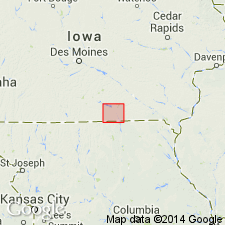
- Usage in publication:
-
- Appanoose beds
- Modifications:
-
- Original reference
- AAPG geologic province:
-
- Iowa shelf
Summary:
Pg. 378-394. Appanoose beds. Shales, limestones, coals, and clays forming lower part of Des Moines stage in Appanoose County. Overlain by Chariton conglomerate (top division of Des Moines stage). Includes Mystic coal. Age is Middle Pennsylvanian.
Named from development in Appanoose Co., IA.
Source: US geologic names lexicon (USGS Bull. 896, p. 61-62).
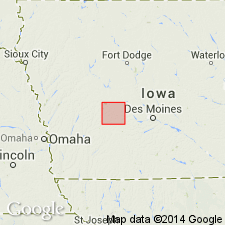
- Usage in publication:
-
- Appanoose formation
- Modifications:
-
- Overview
- AAPG geologic province:
-
- Iowa shelf
Summary:
Pg. 426-469. Divided Des Moines "stage" of Guthrie County, Iowa, into (descending): (1) sandy shale, 40 to 100 feet (probably = Pleasanton shale of Missouri and Kansas); (2) shale, sandstones, and limestones with 3 coals (probably = Appanoose formation of Iowa and Henrietta formation of Missouri); (3) sandstones, sandy shale, coals, etc. corresponding to Cherokee shale of Kansas. Age is Middle Pennsylvanian.
Source: US geologic names lexicon (USGS Bull. 896, p. 61-62).
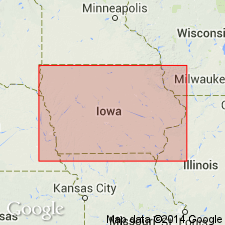
- Usage in publication:
-
- Appanoose beds
- Modifications:
-
- Areal extent
- AAPG geologic province:
-
- Iowa shelf
Summary:
Pg. 102-122. Appanoose beds, near middle of Des Moines formation. include Mystic or Centreville coal, also limestones known as "Bottom rock limestone, "Cap rock limestone", "Thirteen-foot limestone", and "Fifty-foot limestone." Age is Middle Pennsylvanian.
Source: US geologic names lexicon (USGS Bull. 896, p. 61-62).
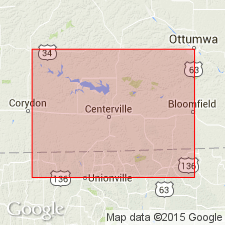
- Usage in publication:
-
- Appanoose formation†
- Modifications:
-
- Abandoned
- AAPG geologic province:
-
- Iowa shelf
Summary:
Pg. 598-604. Appanoose formation = Henrietta formation of Missouri. Consists of (descending): Lonsdale coal, 1 to 2.5 feet; shale with limestone and sandstone seams, 25 to 100 feet; coal and fine clay, 4 to 16 feet; Chariton conglomerate, 15 to 25 feet; shales and limestones, 50 to 100 feet; Mystic coal, 6 to 36 inches; fine clay, 1 to 8 feet; limestone 15 to 35 feet. Underlies Pleasanton shales and overlies Cherokee beds. Age is Pennsylvanian.
Source: US geologic names lexicon (USGS Bull. 896, p. 61-62).
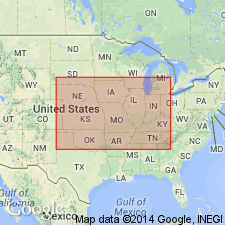
- Usage in publication:
-
- Appanoose group
- Modifications:
-
- Overview
- AAPG geologic province:
-
- Iowa shelf
Summary:
Chart no. 6 (column 31, Iowa, collated by R.C. Moore). Appanoose group. Shown on Pennsylvanian correlation chart as a group comprising strata from unconformity below Mulky coal to base of Pleasanton [shale]. Age is [Middle Pennsylvanian]; Desmoinesian; Westphalian D.
Source: Publication; US geologic names lexicon (USGS Bull. 1200, p. 117-118).
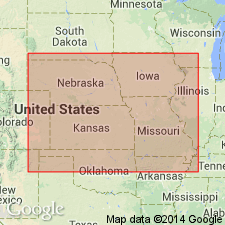
- Usage in publication:
-
- Appanoose group†
- Modifications:
-
- Abandoned
Summary:
Pg. 2027-2028. Appanoose group. Apparently abandoned in favor of Marmaton group. Appanoose includes some upper Cherokee strata and corresponds to Henrietta group as treated by Cline (1939) and redefined by McQueen (1943).
Source: US geologic names lexicon (USGS Bull. 1200, p. 117-118).
For more information, please contact Nancy Stamm, Geologic Names Committee Secretary.
Asterisk (*) indicates published by U.S. Geological Survey authors.
"No current usage" (†) implies that a name has been abandoned or has fallen into disuse. Former usage and, if known, replacement name given in parentheses ( ).
Slash (/) indicates name conflicts with nomenclatural guidelines (CSN, 1933; ACSN, 1961, 1970; NACSN, 1983, 2005, 2021). May be explained within brackets ([ ]).

